Salisbury Incorporation, Wiltshire
Up to 1834
A building on Crane Street in Salisbury operated as the Salisbury parish workhouse from 1634.
In 1770, the Salisbury parishes of St Edmund, St Martin and St Thomas were incorporated under a local Act of Parliament. The Incorporation had powers to set up a Board of Guardians for the administration of poor relief and other local matters, and to operate a workhouse which it continued to do at Crane Street.
The northern part of the building was originally a private house dating back to the 15th century.
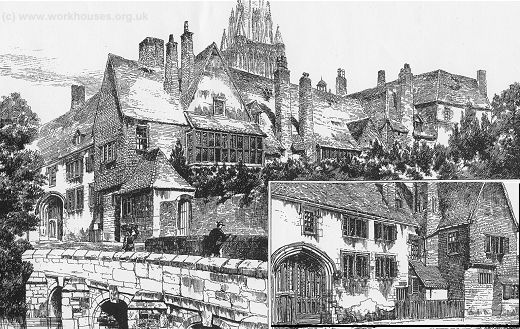
Salisbury parish workhouse from the north-west, c.1880.
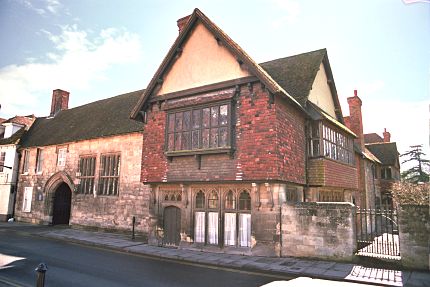
Salisbury parish workhouse from the north-west, 2004.
© Peter Higginbotham.
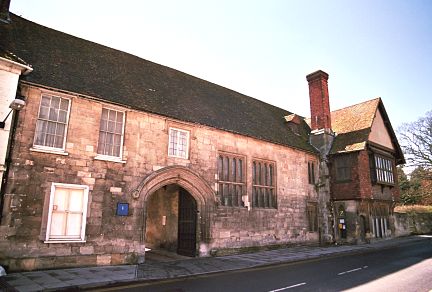
Salisbury parish workhouse north range from the north-east, 2004.
© Peter Higginbotham.
The building was extended in the 16th century by the addition of a new range at the west.
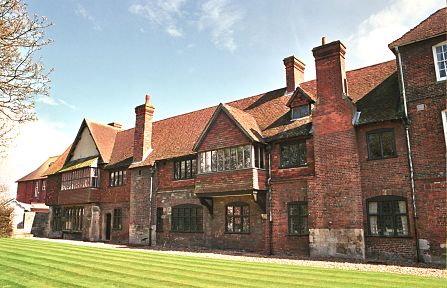
Salisbury parish workhouse west range from south-west, 2004.
© Peter Higginbotham.
Evidence remains of a privy in the west range which discharged into what is now the Cathedral Close ditch which ran like a moat around the west and south edges of the site until being filled in after the diversion of the River Avon.
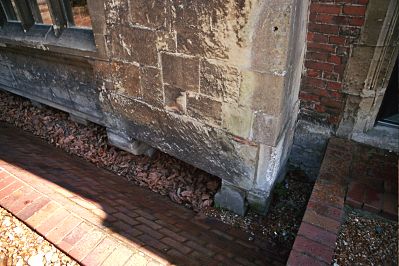
Salisbury parish workhouse privy outlet, 2004.
© Peter Higginbotham.
A further range was added at the south in 1728 which housed the workhouse workshop with dormitories above.
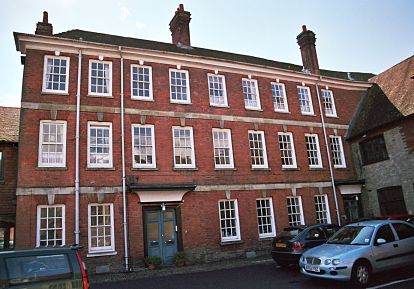
Salisbury parish workhouse south range from the north-east, 2004.
© Peter Higginbotham.
After 1834
Because of its local Act status, Salisbury was exempt from most of the provisions of the 1834 Poor Law Amendment Act. The Incorporation continued in operation until 1869 when it was dissolved along with a number of similar bodies including the thirteen remaining Gilbert Unions. The city's parishes then joined the surrounding Alderbury Poor law Union.
A decade later, the old workhouse was apparently in danger of being demolished, as recorded in a report of 1881:
OLD SALISBURY WORKHOUSE, THREATENED WITH DEMOLITION.
About a year ago the antiquarian world was shocked at an advertisement issued by the Town Council of Salisbury offering the ancient building, which had for some time served as the city workhouse, for sale, with the condition appended that the purchaser should pull the building down, and erect something new on its site, setting it back so as to allow of the street being made wider, and a new bridge being erected.
"Audley House," or The Old Workhouse at Salisbury, was erected during the fifteenth century, by one of the Audley family, but it is not quite certain which. After going through various changes the structure at last became the City Workhouse, and continued to be used until some three years back. The buildings surround three sides of an irregular quadrangle. That which faces the street is the most ancient, and evidently dates from the fifteenth century. On this side is the chief entrance, beneath a well-proportioned four-centred arch, well moulded. The old oak doors still exist, and are valuable examples of Perpendicular panelling. The windows in this portion of the building are square-beaded, with cinquefoil cusped lights. They give light to what was formerly a very elegant hall, but which has been injured by being divided into two stories. The oriole window of the hall looks towards the court-yard, and forms a pretty feature. The kitchen is at the end of the hall, with the solar above it. The latter is lighted by a large bow window looking over the garden in the direction of the river. It contains an original Perpendicular mantel-piece, and bag a good plaster ceiling of a somewhat later date. The windows contain much of their original glazing, and a little stained glass.
The buildings facing the river are of later date than those already described, and were probably erected at various times between the reigns of James I. and Charles II. They are remarkably picturesque, and the grouping of gables, chimneys, and roofs, all crowned by the distant spire of the cathedral, makes up a very pretty picture. In the angle formed by the hall building and the projecting gable of the kitchen is a little pent-house structure, which conceals from external view a very remarkable feature. It is a square-headed opening, divided into two lights, the heads of which are treated in a very different manner. The spandrels of one light are pierced by trefoils, but those of the other are filled in with boldly-carved foliage. The whole is very richly moulded. What this curious feature can have been it is at present difficult to conjecture : it seems too law down for a window, and too high for a doorway ; it is not in the right position for a buttery- hatch. When the brickwork with which it is at present blocked up is removed the difficulty may be solved.
We are glad to bear that there is some chance of this curious and interesting old building being preserved from the destruction which threatened it, as it has been purchased by a member of the cathedral chapter, who is anxious to utilise it without pulling it down and rebuilding it. We have not yet heard whether the Town Council have abandoned their scheme of widening the street and rebuilding the bridge, and until this is settled the fate of the old building hangs in the balance. It is, however, to be hoped that the people of Salisbury will do all in their power to preserve this interesting relic of antiquity. It would be quite worth while to divert the new street a little, so as to accomplish so desirable an act.
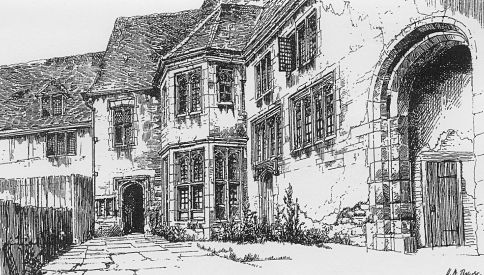
Salisbury parish workhouse, c.1880.
The building was then acquired by the Church of England and now, as Church House, houses the administrative offices of the Salisbury Diocese.
Staff
- (To be added.)
Inmates
Records
Note: many repositories impose a closure period of up to 100 years for records identifying individuals. Before travelling a long distance, always check that the records you want to consult will be available.
- Wiltshire and Swindon Archives, Wiltshire and Swindon History Centre, Cocklebury Road, Chippenham SN15 3QN.
Bibliography
- Higginbotham, Peter The Workhouse Encyclopedia (2014, The History Press)
Links
- None.
Unless otherwise indicated, this page () is copyright Peter Higginbotham. Contents may not be reproduced without permission.


